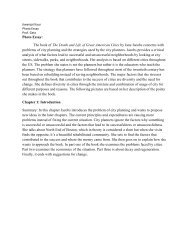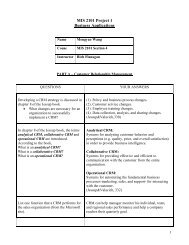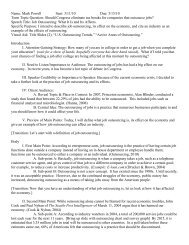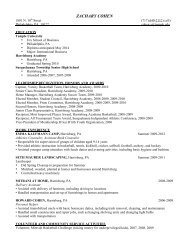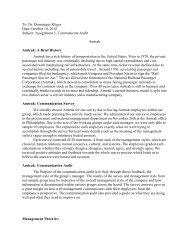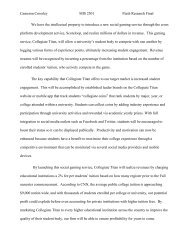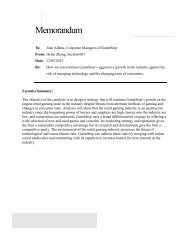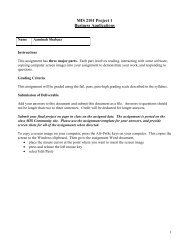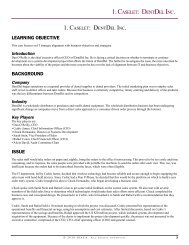Stakeholder analysis for R&D project management - Temple Fox MIS
Stakeholder analysis for R&D project management - Temple Fox MIS
Stakeholder analysis for R&D project management - Temple Fox MIS
You also want an ePaper? Increase the reach of your titles
YUMPU automatically turns print PDFs into web optimized ePapers that Google loves.
<strong>Stakeholder</strong> <strong>analysis</strong> <strong>for</strong> R&D <strong>project</strong><br />
<strong>management</strong><br />
Arun A. Elias, 1 Robert Y. Cavana 1 and Laurie S. Jackson 2<br />
1 School of Business and Public Management, Victoria University of Wellington, New Zealand.<br />
arun.elias@vuw.ac.nz, bob.cavana@vuw.ac.nz<br />
2 School of Earth Sciences, Victoria University of Wellington, New Zealand.<br />
laurie.jackson@vuw.ac.nz<br />
R&D <strong>project</strong>s affect the interests of different stakeholders in different ways. Understanding the<br />
stakeholders and analysing their interests helps in the better <strong>management</strong> of R&D <strong>project</strong>s. In this paper<br />
we discuss a methodology to systematically analyse the stakeholders of R&D <strong>project</strong>s. This methodology<br />
includes Freeman’s (1984) three levels of <strong>analysis</strong>: rational, process and transactional. Based on these<br />
three levels, the stakeholder <strong>management</strong> capability of an R&D <strong>project</strong> is determined. The final stage is<br />
based on Mitchell et al. (1997) approach to analysing the dynamics of stakeholders. This methodology is<br />
illustrated using a New Zealand case relating to a road pricing R&D <strong>project</strong>.<br />
1. Introduction<br />
The research interest in the field of stakeholder<br />
identification, <strong>analysis</strong> and salience is growing.<br />
Since the publication of Freeman’s landmark book,<br />
Strategic Management: A <strong>Stakeholder</strong> Approach<br />
(1984), about a dozen books and more than 100<br />
articles with primary emphasis on the stakeholder<br />
concept have appeared in the <strong>management</strong><br />
literature (Donaldson and Preston, 1995).<strong>Stakeholder</strong><br />
theories are being proposed and experts in the<br />
field are debating over the acceptability of these<br />
theories.<br />
<strong>Stakeholder</strong> issues are important while managing<br />
R&D <strong>project</strong>s (Coombs et al., 1998). We begin this<br />
paper by presenting some examples of stakeholder<br />
issues in the R&D <strong>management</strong> literature.Then, to<br />
get a better understanding of the stakeholder concept,<br />
we explore and classify the stakeholder concepts in<br />
<strong>management</strong> literature.Based on this literature, we<br />
suggest a stakeholder <strong>analysis</strong> methodology suitable<br />
<strong>for</strong> managing R&D <strong>project</strong>s.Finally, we demonstrate<br />
this methodology by presenting a New Zealand case<br />
study.<br />
2. <strong>Stakeholder</strong>s in R&D <strong>management</strong><br />
Researchers in the field of R&D <strong>management</strong> have<br />
acknowledged the importance of stakeholders.Introducing<br />
the scope of fourth generation R&D, Miller<br />
(1995) suggested that participation of multiple stakeholders<br />
would permit concurrent learning and alignment<br />
of multiple sets of stakeholder values.While<br />
trying to extend the definition of stakeholders, he<br />
explained that stakeholders exist beyond the boundary<br />
of a single organisation into a partnership infrastructure.According<br />
to him, fourth generation R&D<br />
applies the concept of participatory design to the<br />
entire innovation system, and integrates the potential<br />
customer (user) and partners into R&D activity,<br />
thereby building overlapping communities of practice.<br />
He also proposed that one of the steps in fourth<br />
generation R&D is per<strong>for</strong>ming prototype tests with<br />
stakeholders.Tipping et al., (1995) noticed that various<br />
R&D stakeholders have different interest and perspectives<br />
on the innovation process and they accommodated<br />
it in a Technology Value Pyramid model<br />
representing a hierarchy of managerial factors.Reijs<br />
(1994), while reporting the Foresight studies in the<br />
R&D Management 32, 4, 2002. # Blackwell Publishers Ltd, 2002.Published by Blackwell Publishers Ltd, 301<br />
108 Cowley Road, Ox<strong>for</strong>d OX4 1JF, UK and 350 Main Street, Malden, MA 02148, USA.
Arun A. Elias, Robert Y. Cavana and Laurie S. Jackson<br />
Netherlands explained that, <strong>for</strong> the success of the<br />
studies, it was essential to bring together different<br />
stakeholders, to create consensus between them on<br />
future directions, and to commit them to the results.<br />
Carter (1997) acknowledged that a principal difficulty<br />
in research administration is communicating the value<br />
of R&D to sponsors and other stakeholders who make<br />
funding decisions.Explaining the challenge of fifth<br />
generation R&D, Rogers (1996) proposes that <strong>management</strong><br />
systems must be collaborative, not competitive<br />
or even cooperative, and focus upon the total<br />
innovation system designed with suppliers, partners,<br />
distributors, and other stakeholders, including customers<br />
– all as integral participants in defining new<br />
frontiers.<br />
A specific area of R&D <strong>management</strong> where stakeholders<br />
become very important is R&D <strong>project</strong><br />
<strong>management</strong>.Identifying key stakeholder issues was<br />
found to be a best practice by Coombs et al.(1998),<br />
while developing benchmarking tools <strong>for</strong> R&D <strong>project</strong><br />
<strong>management</strong>.They have also explained a basic model<br />
of the R&D <strong>project</strong> <strong>management</strong> process consisting six<br />
stages of initial scoping, <strong>project</strong> specification, detailed<br />
planning, action=review cycle, completion and delivery<br />
and post <strong>project</strong> evaluation.Klimstra and Potts (1988)<br />
found that R&D <strong>project</strong> <strong>management</strong> requires the<br />
<strong>management</strong> of interpersonal and group relationships<br />
and the establishment of equality of power and<br />
influence.According to Eckert (1996), one of the<br />
steps that a research administrator should take is to<br />
assemble the team of stakeholders and communicate<br />
with them as needed to ensure good internal working<br />
relationships and processes.Thus, these examples<br />
verify that stakeholder <strong>management</strong> is an important<br />
aspect of R&D <strong>management</strong>.<br />
3. A review of stakeholder literature<br />
The development of the stakeholder concept in the<br />
<strong>management</strong> literature can be classified into different<br />
stages as shown in the stakeholder literature map<br />
(Figure 1).Freeman (1984) developed the first three<br />
levels of this map and we extended the map by<br />
<strong>Stakeholder</strong> concept at<br />
Stan<strong>for</strong>d Research Institute<br />
(1963)<br />
Corporate<br />
Planning<br />
Systems<br />
Theory<br />
Corporate Social<br />
Responsibility<br />
Organisation<br />
Theory<br />
Strategic Management: A<br />
<strong>Stakeholder</strong> Approach<br />
by Freeman (1984)<br />
Descriptive/<br />
Empirical Aspect<br />
Instrumental<br />
Aspect<br />
Normative<br />
Aspect<br />
<strong>Stakeholder</strong> theory<br />
of Corporation by<br />
Donaldson & Preston (1995)<br />
Dynamics of<br />
<strong>Stakeholder</strong>s<br />
More <strong>Stakeholder</strong><br />
Theories<br />
Empirical Studies<br />
Figure 1.<strong>Stakeholder</strong> literature map.<br />
302 R&D Management 32, 4, 2002 # Blackwell Publishers Ltd 2002
<strong>Stakeholder</strong> <strong>analysis</strong><br />
incorporating the later developments in this field.After<br />
its origin in 1963, the concept diversified into four<br />
different fields namely, corporate planning, systems<br />
theory, corporate social responsibility and organisation<br />
theory.We call this stage ‘classical stakeholder<br />
literature’.<br />
The next landmark in the development of stakeholder<br />
literature was the book by Freeman (1984),<br />
Strategic Management: a <strong>Stakeholder</strong> Approach.After<br />
this book, this literature developed around three<br />
different aspects namely, descriptive=empirical aspect,<br />
instrumental aspect and normative aspect.Donaldson<br />
and Preston (1995) brought these three aspects<br />
together in their stakeholder theory of corporation.<br />
Further, the stakeholder literature started spreading<br />
its wings to interesting areas like dynamics of<br />
stakeholders and stakeholder theories.Several empirical<br />
studies were also conducted to validate the<br />
theoretical claims relating to the stakeholder concepts.<br />
A detailed description of this literature map is<br />
available in the paper by Elias et al.(2000).But <strong>for</strong><br />
the scope of this paper we discuss three important<br />
stages in the development of this literature, namely,<br />
classical stakeholder literature, strategic <strong>management</strong>:<br />
a stakeholder approach, and the dynamics of stakeholders.<br />
3.1. Classical stakeholder literature<br />
The origin of ‘stakeholder’ in <strong>management</strong> literature<br />
can be traced back to 1963, when the word appeared in<br />
an international memorandum at the Stan<strong>for</strong>d Research<br />
Institute (cited in Freeman, 1984).<strong>Stakeholder</strong>s<br />
were defined as ‘those groups without whose support the<br />
organisation would cease to exist’.The core concept, in<br />
other words was ‘survival’; without the support of<br />
these key groups, the firm will not survive.<br />
During its <strong>for</strong>mative stage, stakeholder theory itself<br />
had to fight <strong>for</strong> survival, when Ansoff (1965) in his<br />
classic book Corporate Strategy argued <strong>for</strong> the<br />
rejection of stakeholder theory.According to him<br />
‘responsibilities’ and ‘objectives’ were not synonymous<br />
but were made one in stakeholder theory.<br />
By the 1970s stakeholder concepts began to surface<br />
in the strategic planning literature.Taylor (1971)<br />
predicted that the importance of stockholders would<br />
diminish and that, in the 1970s, businesses would be<br />
run <strong>for</strong> the benefit of other stakeholders too.King and<br />
Cleland (1978) came up with a method of analysing<br />
stakeholders in <strong>project</strong> <strong>management</strong>.Hussey and<br />
Langham (1978) developed a model of the organisation<br />
and its environment with stakeholders and used it<br />
in the corporate planning process.<br />
Systems theorists also contributed to the development<br />
of the stakeholder literature in the 1970s.Ackoff<br />
(1974) developed a methodology <strong>for</strong> stakeholder<br />
<strong>analysis</strong> of organisational systems.He argued that<br />
stakeholder participation is essential <strong>for</strong> system design<br />
and the support and interaction of stakeholders would<br />
help in solving many societal problems.Churchman<br />
(1968) also contributed by developing systems theory<br />
to address social issues in an open systems point of<br />
view.The systems model of stakeholders emphasised<br />
participation and argued that problems should not be<br />
defined by focussing or <strong>analysis</strong>, but by enlarging or<br />
synthesising.<br />
Many researchers were also concerned with the<br />
social responsibility of business firms.Post (1981)<br />
categorised the main lines of research in this area,<br />
covering many ideas, concepts and techniques (e.g.<br />
Sethi, 1971; Preston, 1979).The distinguishing feature<br />
of this literature is that the concept was used to include<br />
non-traditional stakeholders who were having adversarial<br />
relationships with the firm.The sub discipline of<br />
<strong>management</strong> called ‘business and society’ developed by<br />
researchers at the School of Management at Berkley<br />
(e.g. Epstein and Votaw, 1978) and Harvard Business<br />
School (e.g. Ackerman, 1975) argued <strong>for</strong> responsiveness<br />
instead of responsibility.<br />
In the organisation theory literature, Rhenman<br />
(1968) used the term stakeholders explicitly to designate<br />
the individuals or groups which depend on the<br />
company <strong>for</strong> the realisation of their personal goals and<br />
on whom the company is dependant.Pfeffer and<br />
Salancik (1978) constructed a model of organisation–<br />
environment interaction and claimed that the effectiveness<br />
of an organisation derives from the <strong>management</strong><br />
of demands, particularly the demands of interest<br />
groups.<br />
Thus, classic stakeholder theory originated on the<br />
concept of survival, falls into four groups namely,<br />
corporate planning, systems theory, corporate social<br />
responsibility and organisational theory (Freeman,<br />
1984).<br />
3.2. Strategic <strong>management</strong>: a stakeholder<br />
approach<br />
Researchers in the stakeholder field differ in their<br />
worldview on stakeholder concepts, but most of them<br />
acknowledge Freeman’s (1984) book Strategic Management:<br />
a <strong>Stakeholder</strong> Approach as a landmark in the<br />
stakeholder literature.In his book, Freeman defines<br />
stakeholders as ‘any group or individual who can affect<br />
or is affected by the achievement of the firm’s objectives’.<br />
He proposed a framework, which fits three levels of<br />
stakeholder <strong>analysis</strong> – rational, process and transactional.At<br />
the rational level, an understanding of ‘who<br />
are the stakeholders of the organisation’ and ‘what are<br />
their perceived stakes’ is necessary.As a technique,<br />
Freeman uses a generic stakeholder map as a starting<br />
point.It is also possible to prepare a stakeholder map<br />
around one major strategic issue.As the next step, a<br />
stakeholder chart is prepared by identifying specific<br />
stakeholders based on the stakeholder map.Further,<br />
the stakes of the specific stakeholder groups are<br />
# Blackwell Publishers Ltd 2002 R&D Management 32, 4, 2002 303
Arun A. Elias, Robert Y. Cavana and Laurie S. Jackson<br />
identified and analysed.He also uses a two dimensional<br />
grid as an analytical device to depict an<br />
organisation’s stakeholders.The first dimension categorises<br />
stakeholders by interest or stake and the second<br />
dimension is in terms of power.He makes the grid<br />
more realistic by improving on the classical stakeholder<br />
grid to prepare a real world stakeholder grid.<br />
At the process level, it is necessary to understand<br />
how the organisation either implicitly or explicitly<br />
manages its relationships with its stakeholders, and<br />
whether these processes fit with the rational stakeholder<br />
map of the organisation.According to Freeman,<br />
existing strategic processes that work reasonably<br />
well could be enriched with a concern <strong>for</strong> multiple<br />
stakeholders.For this purpose, he uses a revised<br />
version of Lorange’s (1980) schema <strong>for</strong> strategic<br />
<strong>management</strong> processes.<br />
The transactional level involves, understanding the<br />
set of transactions or bargains among the organisation<br />
and its stakeholders, and deducing whether these<br />
negotiations fit with the stakeholder map and the<br />
organisational processes <strong>for</strong> stakeholders.According<br />
to Freeman successful transactions with stakeholders<br />
are built on understanding the legitimacy of the<br />
stakeholder and having processes to routinely surface<br />
their concerns.<br />
Broadly, the emphasis of Freeman’s book is to<br />
construct an approach to <strong>management</strong> that takes the<br />
external environment into account in a systematic way.<br />
He provides a solid theoretical basis <strong>for</strong> the understanding<br />
of the stakeholder concept and paved the way<br />
<strong>for</strong> extensive future research in the field.<br />
3.3. Dynamics of stakeholders<br />
Another interesting characteristic of stakeholder concept<br />
is the dynamics of stakeholders.Over time, the<br />
mix of stakeholders may change.New stakeholders<br />
may join and wish to be included in any considerations,<br />
while others may drop out, through no longer<br />
being involved in the process.<br />
The concept of the dynamics of stakeholders was<br />
acknowledged by Freeman (1984), and according to<br />
him, in reality stakeholders change over time, and their<br />
stakes change depending on the strategic issue under<br />
consideration.Alkhafaji (1989) also contributed to<br />
the understanding of this concept.To explain the<br />
dynamics, he defined stakeholders as the ‘groups to<br />
whom the corporation is responsible’.<br />
Another notable work on this concept was by<br />
Mitchell et al.(1997).They proposed that classes of<br />
stakeholders can be identified by the possession or<br />
attributed possession of one or more of three relationship<br />
attributes: power, legitimacy and urgency.According<br />
to them, a party to a relationship has power, to<br />
the extent it has or can gain access to coercive,<br />
utilitarian or normative means, to impose its will in the<br />
relationship.For explaining legitimacy they used the<br />
definition of Suchman (1995).Suchman defined<br />
legitimacy as a generalised perception or assumption<br />
that the actions of an entity are desirable, proper or<br />
appropriate within some socially constructed system of<br />
norms, values, beliefs and definitions.They defined<br />
urgency as the degree to which stakeholder claims call<br />
<strong>for</strong> immediate attention.By including urgency as an<br />
attribute, a dynamic component was added to the<br />
process whereby stakeholders attain salience in the<br />
minds of managers.By combining these attributes they<br />
generated a typology of stakeholders.<br />
According to their typology (Figure 2), if a stakeholder<br />
possesses only one of the three attributes, they<br />
are termed latent stakeholders and have low stakeholder<br />
salience.If the only attribute present is power,<br />
such stakeholders are called dormant stakeholders; if<br />
it is only legitimacy, they are called discretionary<br />
stakeholders and if only urgency, they are called<br />
demanding stakeholders.<strong>Stakeholder</strong> salience will be<br />
moderate, if two attributes are present and such<br />
stakeholders are called expectant stakeholders.Among<br />
the expectant stakeholders, those having power and<br />
legitimacy only are called dominant stakeholders;<br />
those having legitimacy and urgency only are called<br />
dependent stakeholders and those having power and<br />
urgency only are called dangerous stakeholders.<br />
<strong>Stakeholder</strong> salience will be high where all the three<br />
attributes are perceived by managers to be present in a<br />
stakeholder and they are called definitive stakeholders.<br />
Further the dynamic qualities were illustrated by<br />
showing how stakeholders can shift from one class to<br />
another, when the salience of stakeholders increase=decrease<br />
by attaining=losing one or more of the<br />
attributes.Later, Agle et al.(1999) confirmed the<br />
model by empirically testing Mitchell et al.’s (1997)<br />
theoretical model.<br />
POWER<br />
URGENCY<br />
1<br />
Dormant<br />
<strong>Stakeholder</strong> 4<br />
Dominant<br />
<strong>Stakeholder</strong><br />
5<br />
Dangerous<br />
<strong>Stakeholder</strong><br />
3<br />
Demanding<br />
<strong>Stakeholder</strong><br />
7<br />
Definitive<br />
<strong>Stakeholder</strong><br />
6<br />
Dependant<br />
<strong>Stakeholder</strong><br />
Figure 2.<strong>Stakeholder</strong> typology.<br />
Source: Mitchell et al.1997, Figure 2, p.874.<br />
LEGITIMACY<br />
2<br />
Discretionary<br />
<strong>Stakeholder</strong><br />
8<br />
Nonstakeholder<br />
304 R&D Management 32, 4, 2002 # Blackwell Publishers Ltd 2002
<strong>Stakeholder</strong> <strong>analysis</strong><br />
Dynamics of stakeholder is a very interesting and<br />
important aspect of the stakeholder concept.Further<br />
research and empirical studies are required to get a<br />
better understanding and to gain deeper insight of this<br />
area.<br />
4. <strong>Stakeholder</strong> <strong>analysis</strong> <strong>for</strong> a New Zealand<br />
R&D <strong>project</strong><br />
The stakeholder <strong>analysis</strong> methodology we propose<br />
is based on the literature discussed in the previous<br />
sections.Mostly, the literature focuses on an organisation,<br />
while discussing stakeholder <strong>analysis</strong>.We try to<br />
adapt this methodology <strong>for</strong> R&D <strong>project</strong> <strong>management</strong>.<br />
In this section, we illustrate this methodology, using a<br />
New Zealand case study.<br />
The New Zealand case that we use in this study is<br />
based on an R&D <strong>project</strong> managed by the Wellington<br />
Regional Council.Wellington Regional Council has<br />
been seeking a suitable solution to the increasing<br />
problems of congestion, safety and community severance<br />
along the existing state highway route between<br />
Paremata and Paekakariki.A possible solution to<br />
these problems is the construction of the Transmission<br />
Gully motorway, a 27-km inland route.The cost of<br />
constructing Transmission Gully is estimated to be<br />
NZ$245 million.At present, government funding alone<br />
may not meet this cost.This situation suggests the<br />
introduction of road pricing.Thus, if the early<br />
construction of Transmission Gully becomes a reality,<br />
it is likely to be the first application of road pricing in<br />
New Zealand and the principle of ‘doing it right the<br />
first time’ becomes relevant in this case.Due to the<br />
importance of this situation, the Wellington Regional<br />
Council started an R&D <strong>project</strong> to explore the<br />
different aspects of road pricing.<br />
A systematic stakeholder <strong>analysis</strong> <strong>for</strong> this R&D<br />
<strong>project</strong> consists of the following eight steps.The first<br />
seven steps are based on Freeman (1984) and the last<br />
step is based on Mitchell et al.(1997).<br />
(i) Develop a stakeholder map of the <strong>project</strong><br />
(ii) Prepare a chart of specific stakeholders<br />
(iii) Identify the stakes of stakeholders<br />
(iv) Prepare a power versus stake grid<br />
(v) Conduct a process level stakeholder <strong>analysis</strong><br />
(vi) Conduct a transactional level stakeholder <strong>analysis</strong><br />
(vii) Determine the stakeholder <strong>management</strong> capability<br />
of the R&D <strong>project</strong><br />
(viii) Analyse the dynamics of stakeholders<br />
4.1. Develop a stakeholder map of the R&D<br />
<strong>project</strong><br />
For an R&D <strong>project</strong>, the rational level of stakeholder<br />
<strong>analysis</strong> should start with the development of a<br />
stakeholder map.The stakeholder map of the road<br />
pricing R&D <strong>project</strong> is shown in Figure 3.<br />
4.2. Prepare a chart of specific stakeholders<br />
As the next step in rational level <strong>analysis</strong>, a stakeholder<br />
chart is prepared.This chart consists of the specific<br />
stakeholders based on the stakeholder map.For the<br />
road pricing <strong>project</strong> this chart is shown in Figure 4.<br />
Supplier<br />
Government<br />
Legal &<br />
Political<br />
Internal<br />
Customer<br />
Road Pricing R&D Project<br />
Financial<br />
Special Interest<br />
Groups<br />
Media<br />
Citizen<br />
Action<br />
Community<br />
Figure 3.A stakeholder map of the road pricing R&D <strong>project</strong>.<br />
# Blackwell Publishers Ltd 2002 R&D Management 32, 4, 2002 305
Arun A. Elias, Robert Y. Cavana and Laurie S. Jackson<br />
Internal<br />
Financial<br />
Wellington regional councillors<br />
Commercial banks<br />
Regional land transport committee members<br />
Private companies funding companies<br />
Passenger transport committee members<br />
Transfund New Zealand<br />
Environment committee members<br />
The Treasury<br />
WRC environmental <strong>management</strong> department<br />
Inland revenue department<br />
Media<br />
Community<br />
The Dominion newspaper<br />
IWI group - Ngati Toa<br />
Evening Post newspaper<br />
IWI group - Te Ati Awaki Whakarongotai<br />
TV New Zealand<br />
Farming Community: Pastoral Farmers at Horokiri Valley<br />
Radio New Zealand<br />
Forestry: Land Management Group, WRC<br />
Other local newspapers<br />
Property Owners<br />
Citizen Action<br />
Wellington regional residents<br />
Transmission gully action council<br />
Special Interest Groups<br />
Paremata residents association<br />
Department of Conservation<br />
Pukerua bay residents association<br />
Campaign <strong>for</strong> Better City<br />
Plimmerton residents association<br />
Cycle Aware<br />
Mana Esplanade action committee<br />
Friends of Patenui inlet<br />
Save Paremata inlet committee Transport 2000<br />
Pauatahanui residents association<br />
Haywards action group<br />
Tawa progressive and ratepayers association<br />
Gully alternatives in<strong>for</strong>mation network<br />
Waikanae progressive and ratepayers association<br />
Regional Park Users & Officials<br />
Guardians of Pauatahanui inlet<br />
Tranz Rail<br />
Customer<br />
Porirua Gun Club Officials<br />
Commercial road users association<br />
Legal/Political<br />
Regional chamber of commerce<br />
New Zealand police<br />
Public transport users association<br />
Labour party<br />
Other road users<br />
National party<br />
Government<br />
Alliance party<br />
Ministry of Transport<br />
Greens party<br />
Wellington Regional Council<br />
ACT party<br />
Wellington City Council<br />
New Zealand First party<br />
Hutt City Council<br />
Supplier<br />
Upper Hutt City Council<br />
Booz. Allen & Hamilton-Consultants<br />
Kapiti Coast District Council<br />
Beca Carter Hollings & Ferner Ltd.-Consultants:<br />
Porirua City Council<br />
McDermott Miller Ltd. - Consultants<br />
Transit New Zealand<br />
Figure 4.Specific stakeholders of the road pricing R&D <strong>project</strong>.<br />
4.3. Identify the stakes of the stakeholders<br />
Further, the stakes of the specific stakeholder groups is<br />
identified and analysed.In Figure 5 we have shown the<br />
major stakes of some selected stakeholders of the road<br />
pricing R&D <strong>project</strong>.<br />
4.4. Prepare a power versus stake grid<br />
In the next phase of rational level <strong>analysis</strong>, a two<br />
dimensional grid is prepared.The first dimension<br />
categorises the stakeholders by stake and the second<br />
dimension by power.For the road pricing <strong>project</strong>,<br />
this grid <strong>for</strong> some selected stakeholders is shown in<br />
Figure 6.<br />
4.5. Conduct a process level stakeholder<br />
<strong>analysis</strong><br />
After the rational level of <strong>analysis</strong>, it is necessary to<br />
understand how the <strong>project</strong> <strong>management</strong> implicitly<br />
or explicitly manages its relationships with its stakeholders.It<br />
is also important at this stage to know<br />
whether these processes fit with the rational stakeholder<br />
map of the <strong>project</strong>.<br />
While analysing the road pricing R&D <strong>project</strong>, we<br />
found that Wellington Regional Council has a wellstructured<br />
stakeholder consultation process.A threestage<br />
process – identifying needs and most desirable<br />
outcomes; selecting the best package; and confirming<br />
the policies and <strong>project</strong>s was found to ensure ownership<br />
and commitment of stakeholders.This three-stage<br />
process was clearly presented in the Wellington<br />
Regional Land Transport Strategy, 1999–2004 (Wellington<br />
Regional Council, 1999).<br />
4.6. Conduct a transactional level stakeholder<br />
<strong>analysis</strong><br />
At this level, we must understand the set of transactions<br />
or bargains between the <strong>project</strong> <strong>management</strong> and<br />
its stakeholders and deduce whether these negotiations<br />
fit with the stakeholder map and the organisational<br />
processes <strong>for</strong> stakeholders.Successful transactions<br />
with stakeholders are built on understanding the<br />
legitimacy of the stakeholder and having processes to<br />
routinely surface their concerns.<br />
At this stage, it appears that the effectiveness of the<br />
transactions between the <strong>project</strong> managers and stakeholders<br />
is relatively low.Due to the very nature of the<br />
<strong>project</strong>, different stakeholders have conflicting interests.<br />
But these conflicts have not yet been satisfactorily<br />
resolved and this has resulted in a delay of the R&D<br />
<strong>project</strong>.<br />
306 R&D Management 32, 4, 2002 # Blackwell Publishers Ltd 2002
<strong>Stakeholder</strong> <strong>analysis</strong><br />
Regional Land Transport<br />
Committee<br />
Transfund New Zealand<br />
Transit New Zealand<br />
Responsibility <strong>for</strong><br />
regional transport<br />
development<br />
Allocation of available funds<br />
Safe and efficient state highway<br />
system<br />
Management of the needs of<br />
road users and communities<br />
Commercial Road Users<br />
Association<br />
Transmission Gully Action<br />
Council<br />
Regional Chamber of Commerce<br />
High users of the road<br />
Construction of the<br />
Transmission Gully at the<br />
earliest<br />
Needs of local community<br />
Regional business development<br />
Profits of member business<br />
groups<br />
Figure 5.Stakes of selected stakeholders of the road pricing R&D <strong>project</strong>.<br />
Power<br />
Stake<br />
Formal<br />
or<br />
voting<br />
Economic<br />
Political<br />
Equity<br />
Wellington<br />
Regional Council<br />
Economic<br />
Transfund<br />
New Zealand<br />
The Treasury<br />
Inland Revenue<br />
Department<br />
Influencers<br />
Regional Land<br />
Transport<br />
Committee<br />
Transit New Zealand<br />
Regional Chamber<br />
of Commerce<br />
Private funding<br />
companies<br />
Commercial banks<br />
Labour Party<br />
Alliance Party<br />
National Party<br />
Figure 6.<strong>Stakeholder</strong> grid <strong>for</strong> selected stakeholders of the road pricing R&D <strong>project</strong>.<br />
4.7. Determine the stakeholder <strong>management</strong><br />
capability index of the R&D <strong>project</strong><br />
<strong>Stakeholder</strong> <strong>management</strong> capability of an R&D<br />
<strong>project</strong> can be defined as its understanding or<br />
conceptual map of its stakeholders, the processes <strong>for</strong><br />
dealing with these stakeholders and the transactions<br />
which it uses to carry out the achievement of <strong>project</strong><br />
purpose with its stakeholders (Freeman, 1984).To<br />
determine the stakeholder <strong>management</strong> capability we<br />
have to first judge whether the <strong>project</strong> <strong>management</strong><br />
understands its stakeholder map or not.Then, we<br />
have to rate the R&D <strong>project</strong> <strong>for</strong> its organisatonal<br />
process and transactions <strong>for</strong> dealing with its stakeholders.<br />
According to our <strong>analysis</strong>, the road pricing R&D<br />
<strong>project</strong> managers understand their stakeholder map.<br />
Our process level <strong>analysis</strong> gave a high rating <strong>for</strong> the<br />
processes with which they deal with their stakeholders.<br />
But according to us, the effectiveness of the transactions<br />
and bargains between the <strong>project</strong> managers and<br />
stakeholders is relatively low.Based on this <strong>analysis</strong>,<br />
# Blackwell Publishers Ltd 2002 R&D Management 32, 4, 2002 307
Arun A. Elias, Robert Y. Cavana and Laurie S. Jackson<br />
Understands Correct <strong>Stakeholder</strong> Map<br />
High<br />
X<br />
Process<br />
Low<br />
High<br />
Low<br />
Figure 7.<strong>Stakeholder</strong> <strong>management</strong> capability of road pricing R&D <strong>project</strong>.<br />
Transactions<br />
we present the stakeholder <strong>management</strong> capability of<br />
this R&D <strong>project</strong> in Figure 7.<br />
4.8. Analyse the dynamics of stakeholders<br />
The attitudes of stakeholders towards the <strong>project</strong> and<br />
the salience of the stakeholders in the eyes of the<br />
<strong>project</strong> managers change with respect to time.Capturing<br />
this dynamic of stakeholders will enrich the<br />
stakeholder <strong>analysis</strong> of an R&D <strong>project</strong>.<br />
The stakeholder typology model developed by Mitchell<br />
et al.(1997) can be used <strong>for</strong> this purpose.The salience<br />
of stakeholders will change as their power, legitimacy<br />
and urgency changes.Project managers should continuously<br />
update this typology model to capture the changing<br />
salience of stakeholders.A stakeholder typology model<br />
developed during the planning phase of the road pricing<br />
R&D <strong>project</strong>, consisting of some selected stakeholders, is<br />
shown in Figure 8.This typology was made according to<br />
the typology model discussed in Section 3.3.<br />
Dormant<br />
(Power<br />
only)<br />
Discretionary<br />
(Legitimacy only)<br />
Booz. Allen & Hamilton<br />
McDermott Miller<br />
Consultants<br />
Commercial banks<br />
Private funding companies<br />
Demanding<br />
(Urgency only)<br />
Dominant<br />
(Power &<br />
Legitimacy)<br />
The Treasury<br />
Inland Revenue<br />
Department<br />
Dangerous<br />
(Power &<br />
Urgency)<br />
Dependent<br />
(Legitimacy &Urgency)<br />
Transmission Gully<br />
Action Council<br />
Iwi group – Ngati Toa<br />
Transport 2000<br />
Definitive<br />
(Power, Legitimacy & Urgency)<br />
Regional Land Transport<br />
Committee<br />
Transit New Zealand<br />
Transfund New Zealand<br />
Wellington Regional Chamber<br />
of Commerce<br />
Non-stakeholder<br />
(No Power,<br />
Legitimacy or<br />
Urgency)<br />
Figure 8.<strong>Stakeholder</strong> typology <strong>for</strong> selected stakeholders of road pricing R&D <strong>project</strong>.<br />
308 R&D Management 32, 4, 2002 # Blackwell Publishers Ltd 2002
<strong>Stakeholder</strong> <strong>analysis</strong><br />
5. Comments by the New Zealand R&D<br />
<strong>project</strong> managers<br />
A report was submitted to the Wellington Regional<br />
Council based on the stakeholder <strong>analysis</strong> outlined in<br />
the previous sections.In general, they found this work<br />
to be very useful <strong>for</strong> their transport policy work.In<br />
particular, Brennand and Sargent (personal communication)<br />
indicated that this work:<br />
* provides a new way of examining a policy issue<br />
which differs from techniques frequently used in the<br />
transportation planning (i.e. in the road pricing<br />
R&D <strong>project</strong>s).This is truly innovative work, which<br />
provides new insights into difficult issues.<br />
* developed a process that provided insights into<br />
addressing the stakeholder concerns that were<br />
created by a transportation problem.A useful result<br />
of the process was a very clear identification of<br />
where the policy conflicts of a proposal lay in the<br />
minds of stakeholders.<br />
* confirmed other investigations undertaken by Council<br />
such as the preferred funding mechanisms <strong>for</strong><br />
funding the implementation of the highway <strong>project</strong>.<br />
It provided a useful tool to differentiate between<br />
stakeholder preferences important policy initiatives<br />
such as toll funding, government funding, regional<br />
rates and regional petrol tax.This tool has invaluable<br />
applications <strong>for</strong> Council when major policy initiatives<br />
such as road pricing are considered.<br />
* provided useful insights into the effectiveness of<br />
in<strong>for</strong>mation transfer between <strong>project</strong> <strong>management</strong><br />
and stakeholder groups.This is very important to<br />
Council as it has a statutory obligation to consult on<br />
its proposals.<br />
6. Conclusions<br />
In this paper we have combined Freeman (1984) and<br />
Mitchell et al.’s (1997) approaches to stakeholder<br />
<strong>analysis</strong> and demonstrated that this is an appropriate<br />
framework <strong>for</strong> analysing stakeholders <strong>for</strong> R&D<br />
<strong>project</strong>s.Freeman’s (1984) methodology includes three<br />
levels of <strong>analysis</strong>: rational, process and transactional.<br />
Based on these three levels, the stakeholder <strong>management</strong><br />
capability of an R&D <strong>project</strong> is determined.The<br />
final stage includes Mitchell et al.’s (1997) approach<br />
to analysing the dynamics of stakeholders.Thus,<br />
this methodology provides a systematic approach to<br />
analysing who are the stakeholders; what are their<br />
interests; and how these may change over time.<br />
This methodology is illustrated using a New Zealand<br />
case relating to road pricing <strong>for</strong> a major R&D<br />
infrastructure <strong>project</strong>.In this case, managers were<br />
positive in their assessment of the value of understanding<br />
stakeholder interests and the general approach<br />
taken in this research.The stakeholder <strong>analysis</strong><br />
then laid the foundations <strong>for</strong> in depth group model<br />
building sessions to investigate the wider <strong>project</strong>.<br />
A number of authors in the recent R&D <strong>management</strong><br />
literature have discussed the importance of<br />
recognising and working with stakeholders (e.g. Miller,<br />
1995; Tipping et al., 1995; Eckert, 1996; Rogers, 1996;<br />
Coombs et al., 1998). Our study has described a<br />
methodology and actual application to first identify<br />
and classify who those stakeholders are, and how to<br />
analyse their interests, so that the involvement and<br />
communication throughout an R&D <strong>project</strong> can be<br />
more valid and meaningful.<br />
In conclusion, we believe that the methodology<br />
outlined in this paper would be very useful at the<br />
earliest stages and throughout the <strong>management</strong> of<br />
many R&D <strong>project</strong>s.<br />
7. Acknowledgements<br />
The authors would like to gratefully acknowledge all<br />
the assistance received in the preparation of this paper.<br />
In particular we would like to thank Tony Brennand,<br />
Manager Transport Policy and Planning, and Nick<br />
Sargent, Senior Transport Planner of the Wellington<br />
Regional Council (New Zealand) <strong>for</strong> their support and<br />
written feedback.However, the opinions and interpretations<br />
contained within this paper are the authors’<br />
own.<br />
References<br />
Ackoff, R.(1974) Redesigning the Future.New York: Wiley.<br />
Ackerman, R.(1975) The Social Challenge to Business.<br />
Cambridge MA: Harvard University Press.<br />
Agle, B.R., Mitchell, R.K. and Sonnenfield, J.A. (1999) Who<br />
matters to CEOs An investigation into stakeholder<br />
attributes and salience, corporate per<strong>for</strong>mance and CEO<br />
values. Academy of Management Journal, 42, 5, 507–525.<br />
Alkhafaji, A.F. (1989) A <strong>Stakeholder</strong> Approach to Corporate<br />
Governance. Managing in a Dynamic Environment.Westport<br />
CT: Quorum.<br />
Ansoff, I.(1965) Corporate Strategy.New York: McGraw<br />
Hill.<br />
Carter, R.(1997) Financial <strong>analysis</strong> <strong>for</strong> R&D decisions.SRA<br />
Journal, 29, 1,2, 5–15.<br />
Churchman, C.W. (1968) The Systems Approach.New York:<br />
Dell.<br />
Coombs, R., McMeekin, A.and Pybus, R.(1998) Toward<br />
the development of benchmarking tools <strong>for</strong> R&D <strong>project</strong><br />
<strong>management</strong>. R&D Management, 28, 3, 175–186.<br />
Donaldson, T.and Preston, L.(1995) The stakeholder theory<br />
of the corporation: concepts, evidence and implications.<br />
Academy of Management Review, 20, 1, 65–91.<br />
Eckert, J.L. (1996) Preparing to manage an international<br />
<strong>project</strong>. SRA Journal, 28, 1=2, 33–36.<br />
Elias, A.A., Cavana, R.Y. and Jackson, L.S. (2000) Linking<br />
stakeholder literature and system dynamics: opportunities<br />
<strong>for</strong> research. Proceedings of the International Conference on<br />
# Blackwell Publishers Ltd 2002 R&D Management 32, 4, 2002 309
Arun A. Elias, Robert Y. Cavana and Laurie S. Jackson<br />
Systems Thinking in Management, Geelong, Australia,<br />
pp.174–179.<br />
Epstein, E.M. and Votaw, D. (1978) Rationality, Legitimacy,<br />
Responsibility: the Search <strong>for</strong> New Directions in Business<br />
and Society.Santa Monica CA: Goodyear Publishing<br />
Company.<br />
Freeman, R.E. (1984) Strategic Management: a <strong>Stakeholder</strong><br />
Approach.Boston MA: Pitman.<br />
Hussey, D.and Langham, M.(1978) Corporate Planning: the<br />
Human Factor.Ox<strong>for</strong>d: Pergamon.<br />
King, W.and Cleland, D.(1978) Strategic Planning and<br />
Policy.New York: Van Nostrand Reinhold.<br />
Klimstra, P.D. and Potts, J. (1988) What we’ve learned:<br />
managing R&D <strong>project</strong>s. Research Technology Management,<br />
31, 3, 23–39.<br />
Lorange, P.(1980) Corporate Planning: an Executive Viewpoint.Englewood<br />
Cliffs NJ: Prentice Hall.<br />
Miller, W.L. (1995) A broader mission of R&D. Research<br />
Technology Management, 38, 6, 24–36.<br />
Mitchell, R., Agle, B. and Wood, D. (1997) Towards a theory<br />
of stakeholder identification and salience: defining the<br />
principle of who and what really counts. Academy of<br />
Management Review, 22, 4, 853–886.<br />
Pfeffer, J.and Salancik, G.(1978) The External Control of<br />
Organizations, New York: Harper and Row.<br />
Post, J.(1981) Research in business and society: current<br />
issues and approaches.Presented at AACSB Conference on<br />
Business Environment=Public Policy and the Business<br />
School of the 1980s, Berkeley CA.<br />
Preston, L.(1979) Research in Corporate Responsibility and<br />
Social Policy, Volume 1.Greenwich: JAI Press.<br />
Reijs, J.(1994) Foresight studies undertaken by the Ministry<br />
of Economic Affairs in the Netherlands. R&D Management,<br />
24, 2, 167–174.<br />
Rhenman, E.(1968) Organisationsplanering.Stockholm: PA<br />
Norstedt & Soner.<br />
Rogers, D.M.A. (1996) The challenge of fifth generation<br />
R&D. Research Technology Management, 39, 4, 33–41.<br />
Sethi, P.(1971) Up Against the Corporate Wall.Englewood<br />
Cliffs NJ: Prentice Hall.<br />
Suchman, M.C. (1995) Managing legitimacy: strategic and<br />
institutional approaches. Academy of Management Review,<br />
20, 3, 571–610.<br />
Taylor, B.(1971) The future development of corporate<br />
strategy. The Journal of Business Policy, 2, 2, 22–38.<br />
Tipping, J.W., Zeffren, E. and Fusfeld, A.R. (1995) Assessing<br />
the value of technology. Research Technology Management,<br />
38, 5, 22–39.<br />
Wellington Regional Council (1999) The Wellington Regional<br />
Land Transport Strategy, 1999–2004.Wellington.<br />
310 R&D Management 32, 4, 2002 # Blackwell Publishers Ltd 2002




